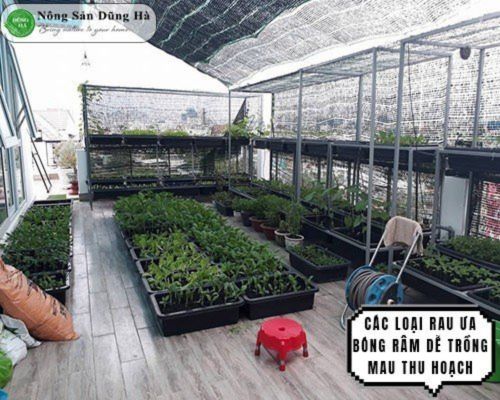Today, to achieve the huge revenue from growing vegetables brings. Many people have not hesitated to use toxic chemical drugs to stimulate the vigorous growth of vegetables. The use of drugs in livestock will seriously affect human health. In big cities, many women are tending to grow clean vegetables at home to ensure their health. Many people are learning about shade-loving vegetables but are facing many difficulties. The following article, Dried Agricultural Products will answer in detail the shade-loving vegetables, the more shade they “grow as fast as blowing” so that you can grow them right at your little house.
1. What are shade-loving vegetables?
Shade-loving vegetables are also known as shade-tolerant vegetables, shade-loving vegetables, shade-loving vegetables or vegetables that need little sunlight. This is a phrase that farmers want to refer to vegetables that grow in low light conditions.
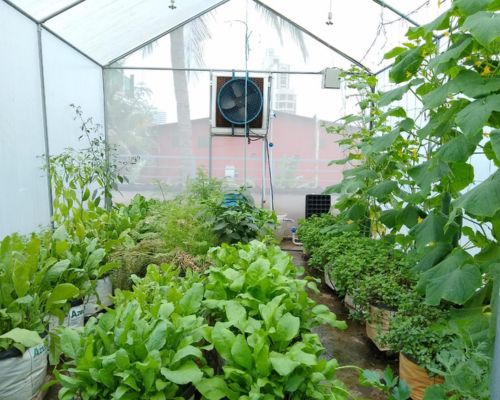
Most of the vegetables they need light for photosynthesis, to grow. However, each type of vegetable they need different light intensity to grow. There are vegetables that tolerate the sun well, the bigger the sun, the stronger they grow. But there are also varieties that cannot tolerate high temperatures, they only grow well when the light intensity is low.
The cultivation of these shade-loving vegetables also needs to have their own principles. If planting in a large garden, you need to have a shading net system to reduce the temperature and lighting time. If growing at home (in balconies, terraces,…) plant them in cool places, where light intensity is low.
See also: WHAT VEGETABLES TO KEEP COLD TEMPERATURES IN WINTER?
2. How does light affect the growth of vegetables?
Light has a huge impact on the growth of plants. Specifically:
- Brightness: Vegetables need a sufficient amount of light to grow. Light is the source of “free energy” for vegetables to photosynthesize. Vegetables grown will convert solar energy into Glucose for growth. Light levels depend on the type of vegetable grown and the stage of growth
- Light time: The length of time receiving light per day also affects the growth rate more or less. Each type of vegetable needs different lighting time to grow. For short-term vegetables, the lighting time will be about 6-8 hours/day. With long-term fruits and vegetables, the lighting time is from 8-10 hours/day
- Canopy: Canopy is the extent to which large trees cover smaller trees, which also affects the light they receive. If the small tree is covered too much by the large trees, the light cannot reach enough and the plant will also become weak, and the yield will be poor.
In short, light plays an extremely important role in the growth rate of vegetables. To ensure good growth of vegetables, quick harvest, no pests, … it is extremely important to provide and plant them where there is enough light time/day. So do you know what shade-loving vegetables include? Let’s find out together.
See more: [Synthesis] Sun-tolerant vegetables – the bigger the sun, the better they grow
3. Shade-loving vegetables, the more shady the more tired the hand harvest?
3.1 Vegetables of the vine family
The first list of
shade-loving vegetables you need to remember is
those of the vines family. Typically
, spinach seeds, cove beans seeds, peas seeds, cucumber seeds, bitter melon seeds, kohlrabi seeds,… these vegetables all appear popular. on the tray of rice and each type has different processing methods to bring its own delicious flavors.
The common feature of the above vegetables is that they are only suitable for living in shady places and cannot tolerate high temperatures. They only photosynthesize, absorbing nutrients for about 3-5 hours in the morning.

In addition, the vegetables belong to the vines family, when growing you also need to make a trellis for them to climb to get a good product. For example,
cove beans or
peas. If you want to have elongated, edible, sweet-cooked beans, you definitely cannot help but make a truss. These climbing plants you should plant them on the terrace so they have a lot of space.
Water is the key to good plant growth. If you plant in a place with a lot of light, you need to water it twice a day. Also planted in shady places, only need to water once a day. Time ranges from 40 – 60 days that you can harvest the finished product depending on the variety planted.
See more: (From A – Z) What Vegetables to Grow in the North Fast Harvest in February?
3.2 Spinach seeds
Spinach seeds are the next vegetable that you should grow them in shady places. Spinach can be grown all year round, yielding carrots and harvesting time is very fast. This variety of spinach is only adapted to cool climates. But with the constant development of science, they have successfully researched a heat-resistant spinach variety that can be grown in areas with hot climates.
Spinach is a herbaceous, smooth-stemmed, upright plant. Leaves are ovate-shaped, pale green, serrated edges, leaf veins like propellers. Many people often confuse collard greens with spinach.
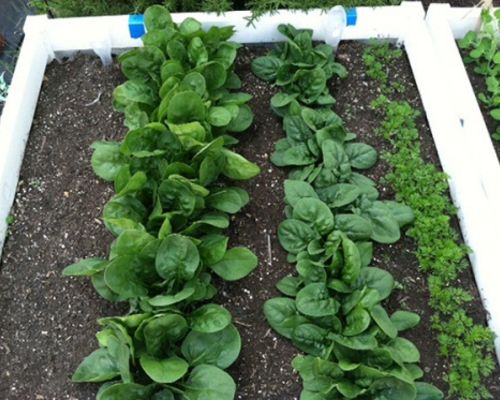
Spinach prefers to grow in areas with loose loamy soil, rich in nitrogen and potassium fertilizers. Spinach variety thrives at a temperature of 15-20 degrees Celsius. Above 25 degrees Celsius, the growth rate slows down. Soil is ready. Before sowing, you need to soak in warm water about 75 degrees Celsius. Continue to incubate the seeds with a clean towel for 2 days to crack the flax seeds.
Sow the seeds directly into the ground. Cover the surface of the soil with a layer of straw. Water the straw just enough, avoid watering too much to drown the seeds. Spinach likes moisture and shade. In the summer, remember to water every 2 days. In the cool season, water once a day. It takes about 30 – 50 days for you to harvest spinach.
See more: What kind of vegetables to grow at home in the fall, which is suitable for the weather, hand-tied picking?
3.3 Centella asiatica seeds
Centella asiatica seeds are very suitable for you to sow on shady days. Gotu kola is a vegetable with many good uses for human health. Many people use gotu kola as an oriental medicine, cooling the liver and cooling the body. Gotu kola has a very strong vitality. You can plant them anywhere you like. Even if you accidentally step on them, they still won’t die.
Growing gotu kola at home is very simple. You just need to use a styrofoam box (plastic pots, aluminum trays,…) to successfully grow gotu kola. The soil you should choose is very soft to porous, light sandy soil. You mix the soil with animal manure, nitrogen fertilizer or potassium fertilizer so that the soil has enough nutrients to grow plants. Let the soil rest for about 1 day. When you buy gotu kola seeds, soak them in warm water of 75 degrees Celsius for 4-6 hours. Pick up the seeds, incubate in a clean towel for 2 days to crack the flax seeds.
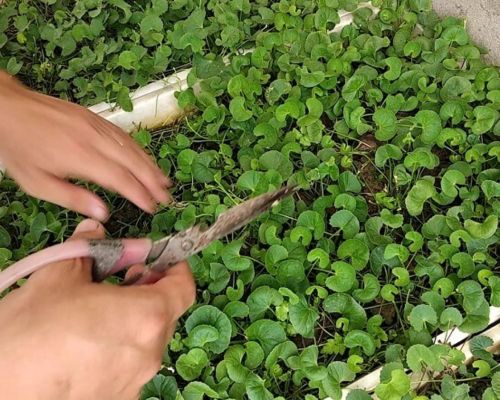
Soil and seeds are ready. You sprinkle the seeds of pennywort evenly on the ground. Cover the surface of the soil with a layer of straw. Water the straw with sufficient amount of water.
About 5-7 days, centella asiatica seeds begin to sprout from the ground. About 45 – 50 days is when you proceed to harvest gotu kola. One crop, gotu kola will give you a harvest of 8-10 batches. Use your hands to grab the young vegetables to eat. Add fertilizer so that they continue to produce new shoots.
See more: What vegetables to grow in April in the North? TOP 5+ vegetables grown in April?
3.4 Lettuce seeds
Your family often eats grilled on cold days. Definitely a vegetable that you can’t forget when eating grilled is lettuce. Each lettuce wrapped with grilled meat, adorned with a little kimchi and dipped with tamarind sauce is a wonderful thing. Currently, on the market, there are many types of lettuce that are popular with many people. Each type of lettuce corresponds to the type of seed that produces them. Specifically:
The common feature of these lettuce seeds is that they are only suitable for growing in cool climates. The appropriate temperature for lettuce for good yield is 15 – 30 degrees Celsius. Above 30 degrees Celsius, the plant still gives good growth but low yield, slow harvest.
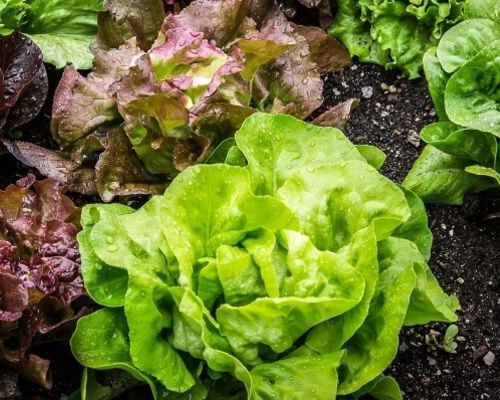
Plastic trays, styrofoam boxes are simple materials for you to grow lettuce at home. Lettuce likes to grow with loose soil, soil mixed with animal manure, dark manure, potassium fertilizer and humus-rich soil. Lettuce seeds are small, so you don’t need to soak them but sow them directly into the finished ground. Sow about 10cm apart so that the plants grow evenly.
Lettuce is very moist. You should water at least once a day. About 35 days you can harvest lettuce. One crop of lettuce, you can eat 3-5 crops.
See more: What vegetables to grow in January in the North? 5+ vegetables grown in January?
3.5 Bok choy seeds
The last list of today’s
shade-loving vegetables you can’t miss is
bok choy seeds. Cabbage is a vegetable that appears very commonly on Vietnamese rice trays. Spinach is a shade-loving vegetable that is not suitable for growing in areas with high light temperatures. The right time to sow bok choy is winter, early spring and early summer.
Broccoli has good growth rate, high yield, quick harvest and excellent resistance to pests and diseases. Temperatures ranging from 10 to 28 degrees Celsius are very suitable for growing bok choy. Temperatures above 30 degrees Celsius, bok choy still grows well, but you must water regularly.
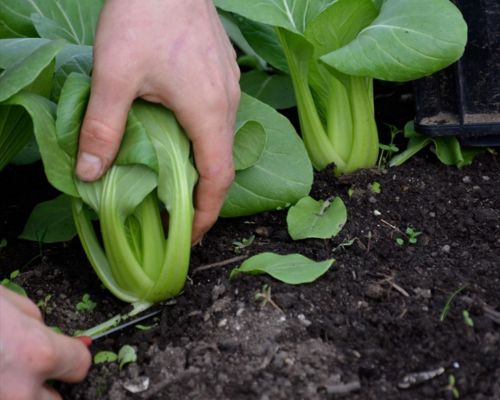
Growing bok choy at home is very simple. Cabbage likes loose soil. The soil you should mix with animal manure, fertilize with potassium and nitrogen fertilizers so that the soil has enough nutrients to grow plants. Let the soil rest for about 1 day. You should soak the bok choy seeds in warm water of 75 degrees Celsius for 3-5 hours. Pick up the seeds, incubate the seeds with a clean towel for about 2 hours to crack the flax seeds.
Land is done. The last thing you should do is sow the seeds of bok choy evenly into the ground. It takes about 5-7 days, the plant begins to sprout, so it should be out of the ground. About 35 days you can harvest bok choy. Use your hands to pull the bok choy out of the ground. Chickpeas can be used to cook green or stir-fry very delicious.
See also: WHAT VEGETABLES TO GROW IN MARCH WHAT HAPPENED IN THE NORTH?
4. Conclude
Above is the article that answers the question of how to grow shade-loving vegetables that Dried Agricultural Products has shared with readers. There are still a lot of other shady vegetables, but here are 5 vegetables that are easy to grow, easy to fertilize, quickly to harvest, less pests and commonly appear on the rice tray of every family. With just a few basic steps, you have a “mini green vegetable garden” right in your beloved home. Wish you always success!
If you have a need to order clean vegetable seeds with a high germination rate. Please contact us via Hotline: 1900 986865 dear!
Or, visit the product in person at the following address:
- CN1: No. 11 Kim Dong – Giap Bat Street – Hoang Mai District – Hanoi City
- CN2: A10 – Alley 100 – Trung Kinh Street – Yen Hoa Ward – Cau Giay District – Hanoi City
- CN3: No. 02/B, Quarter 3 – Trung My Tay 13 Street – District 12 – Ho Chi Minh City
See also: {UPDATE} What Vegetables Grow In The Rainy Season With Little Care?








 Tiếng Việt
Tiếng Việt